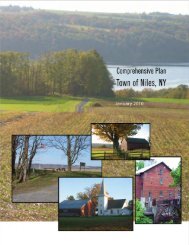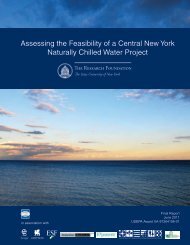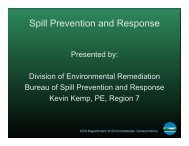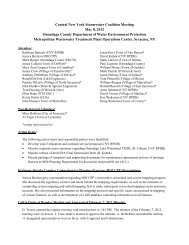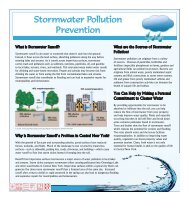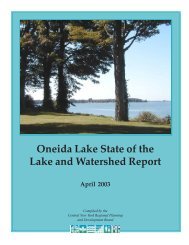A Management Strategy for Oneida Lake and its ... - CNY RPDB Home
A Management Strategy for Oneida Lake and its ... - CNY RPDB Home
A Management Strategy for Oneida Lake and its ... - CNY RPDB Home
You also want an ePaper? Increase the reach of your titles
YUMPU automatically turns print PDFs into web optimized ePapers that Google loves.
Catching crayfish in Chittenango Creek<br />
(Photo: Saltman)<br />
l<strong>and</strong> use, overwithdrawal, <strong>and</strong> groundwater<br />
contamination as development pressures<br />
increase, particularly in the southern portion<br />
of the watershed.<br />
Flora <strong>and</strong> Fauna<br />
Geology, topography, soil, climate, <strong>and</strong> l<strong>and</strong><br />
use patterns influence the distribution of flora<br />
<strong>and</strong> fauna. From upl<strong>and</strong>s to lowl<strong>and</strong>s, the<br />
<strong>Oneida</strong> <strong>Lake</strong> watershed provides diverse<br />
habitats that sustain a healthy <strong>and</strong> productive<br />
assemblage of plant <strong>and</strong> animal species.<br />
Changes in l<strong>and</strong> use patterns have the potential<br />
to threaten the health, well being, <strong>and</strong> in<br />
some cases, the survival of several plant <strong>and</strong><br />
animal wildlife species. Despite these<br />
changes, the <strong>Oneida</strong> <strong>Lake</strong> watershed is home<br />
to a number of rare, threatened, <strong>and</strong> endangered<br />
plants <strong>and</strong> animals of state, national, <strong>and</strong><br />
global significance. For example, the Chittenango<br />
ovate amber snail, Bog Turtle, <strong>and</strong><br />
Hart’s-Tongue fern, all species on the United<br />
States Threatened Species List, are found in<br />
the <strong>Oneida</strong> <strong>Lake</strong> watershed. The Indiana bat,<br />
also found in the watershed, is a federally<br />
listed endangered species.<br />
Wetl<strong>and</strong>s<br />
Wetl<strong>and</strong>s are found throughout the <strong>Oneida</strong><br />
<strong>Lake</strong> watershed but are especially concentrated<br />
in the <strong>Lake</strong> Plain region, an area characterized<br />
by a high water table <strong>and</strong> flooding.<br />
Wetl<strong>and</strong> types found in the <strong>Oneida</strong> <strong>Lake</strong><br />
watershed vary from <strong>for</strong>ested, seasonally<br />
flooded swamps to open marshes of grasses,<br />
sedges, <strong>and</strong> other low growing species.<br />
Wetl<strong>and</strong>s provide excellent habitat <strong>for</strong> migratory<br />
waterfowl <strong>and</strong> serve as wintering yards<br />
<strong>for</strong> many animal species that utilize the low<br />
growing vegetation <strong>for</strong> cover <strong>and</strong> a year-round<br />
food source. Wetl<strong>and</strong>s also act as sedimentation<br />
areas <strong>and</strong> filtering basins to remove<br />
impurities, thereby enhancing water quality.<br />
By slowing runoff <strong>and</strong> temporarily storing<br />
excess surface water, wetl<strong>and</strong>s protect downstream<br />
areas from flooding. Under certain<br />
hydrological conditions, wetl<strong>and</strong>s can recharge<br />
groundwater <strong>and</strong> augment surface<br />
water flow. Wetl<strong>and</strong>s adjacent to waterbodies<br />
also provide spawning <strong>and</strong> nursery grounds,<br />
supply food, <strong>and</strong> lend protection to fish <strong>and</strong><br />
other aquatic species. As an added benefit,<br />
wetl<strong>and</strong>s provide excellent recreational,<br />
aesthetic, <strong>and</strong> educational opportunities.<br />
A significant threat to the wetl<strong>and</strong>s of the<br />
<strong>Oneida</strong> <strong>Lake</strong> watershed is commercial <strong>and</strong><br />
residential development. The impacts from<br />
urbanization have degraded wetl<strong>and</strong>s near the<br />
lake as well as in upl<strong>and</strong> areas. Reduced<br />
wetl<strong>and</strong> acreage has decreased the potential<br />
<strong>for</strong> runoff retention of urban <strong>and</strong> agricultural<br />
pollutants, <strong>and</strong> has reduced water storage<br />
capacity during periods of excessive precipitation.<br />
Stormwater problems in the watershed<br />
are also more prevalent due to the conversion<br />
of wetl<strong>and</strong>s to urban <strong>and</strong> agricultural l<strong>and</strong>.<br />
Wetl<strong>and</strong> losses reduce the ability of the<br />
watershed to store water <strong>and</strong> consequently<br />
increase the region’s susceptibility to high<br />
water damage. Another threat to wetl<strong>and</strong>s in<br />
the <strong>Oneida</strong> <strong>Lake</strong> watershed is a non-native<br />
plant called purple loosestrife. This plant<br />
thrives in marshes <strong>and</strong> ditches, out-competes<br />
indigenous flora, <strong>and</strong> makes wetl<strong>and</strong>s less<br />
suitable <strong>for</strong> wildlife habitat.<br />
page 16<br />
Chapter 2: <strong>Oneida</strong> <strong>Lake</strong> <strong>and</strong> Its Watershed



